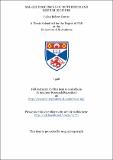Files in this item
Sol-gel processing of ruthenium and iridium dioxides
Item metadata
| dc.contributor.advisor | Crayston, Joe A. | |
| dc.contributor.advisor | Richens, David T. | |
| dc.contributor.author | Osman, Julian Robert | |
| dc.coverage.spatial | 208 p. | en_US |
| dc.date.accessioned | 2018-07-02T08:42:34Z | |
| dc.date.available | 2018-07-02T08:42:34Z | |
| dc.date.issued | 1998 | |
| dc.identifier.uri | https://hdl.handle.net/10023/14771 | |
| dc.description.abstract | The synthesis of the Ru₄O₆⁴⁺(aq) ion and attempts to produce derivative complexes of it are explored. Although crystals suitable for examination by single crystal X-Ray crystallography were not obtained, the core structure of the Ru₄Os⁴⁺ ion in solution has been successfully determined using Ru K edge EXAFS spectroscopy. The refined results for solutions of the ion in aqueous acid, provide strong indications that the ion has an adamantanoid core arrangement in solution and that core structures based on hydroxo groups i.e Ru4(OH)₁₂⁴⁺ can be ruled out. Preparation and controlled hydrolysis of a variety of ruthenium precursors aimed at preparing gels of RuO₂.nH₂O gave at best powders. For example, only RuO₂ powders were obtained by raising the pH of solutions of the Ru₄O₆⁴⁺+ ion. However, gels of a RuO₂-TiO₂ mixed oxide were readily prepared from the alkoxides. From TGA/DTA, X-Ray, and electron microscopy data these proved to be a mixture of two different oxide phases rather than a solid solution, hi some samples the RuO₂ phase contains some of the smallest RuO₂ nanoparticles so far reported. The mixed oxide gels and powders obtained were found to contain a number of impurities. Work performed on the iridium aqua ion [Ir(H₂O)₆]³⁺ is reported along with experiments to produce mixed IrO₂-TiO₂ oxides using iridixun ethoxide and iridium acetate complexes as starting materials. The aqua ion was found to give a powder product but gels were obtained from the other two precursors. The gels have been characterized and it was found that IrO₂ is highly dispersed within a TiO₂ matrix. The electrocatalytic properties of the IrO₂ containing gels have been determined by studying the rates of oxygen evolution and the rate of consumption of cerium (IV) ions. The results show that the sol-gel derived IrO₂ systems show good activity towards catalysing oxygen evolution by these ions. | en_US |
| dc.language.iso | en | en_US |
| dc.publisher | University of St Andrews | |
| dc.subject.lcc | QD181.R9O8 | |
| dc.subject.lcsh | Ruthenium | en |
| dc.title | Sol-gel processing of ruthenium and iridium dioxides | en_US |
| dc.type | Thesis | en_US |
| dc.contributor.sponsor | Engineering and Physical Sciences Research Council (EPSRC) | en_US |
| dc.contributor.sponsor | Johnson Matthey Plc. | en_US |
| dc.type.qualificationlevel | Doctoral | en_US |
| dc.type.qualificationname | PhD Doctor of Philosophy | en_US |
| dc.publisher.institution | The University of St Andrews | en_US |
This item appears in the following Collection(s)
Items in the St Andrews Research Repository are protected by copyright, with all rights reserved, unless otherwise indicated.

